
Biography: Part 1
The Early Years
Lee Majors was born in Wyandotte, Michigan, Harvey Lee Yeary [Lee took his acting name Lee Majors, from the University of Tennesse football coach Johnny Majors], on the 23rd of April 1939,. He grew up in Middleboro, Kentucky, where he had been adopted by relatives after the death of his parents, when he was less than three years old.
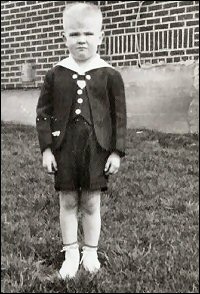 He discovered about his adoption on rainy afternoon during his teenage years. He was alone in the house, and overcome with boredom when for some reason he decided to go up into the attic and start poking around in the old boxes and suitcases he found there.
He discovered about his adoption on rainy afternoon during his teenage years. He was alone in the house, and overcome with boredom when for some reason he decided to go up into the attic and start poking around in the old boxes and suitcases he found there.
He came across a bundle of newspaper clippings all from the same period, which mentioned the deaths of a man and a woman, one killed in a road accident fatality, the other a factory-related incident. Reading through the old clippings, Lee learnt the awful truth about his “real” parents. “Both my parents were killed. My father in a steel mill accident just before I was born, and a couple of years later, my mother was hit by a drunk driver as she was standing on a corner waiting to go to her job as a nurse.” The report went on to say that the couple left behind a child – a boy – who had been adopted by relatives, a Harvey and Mildred Yearly, of Kentucky. Lee realized he was the surviving child the article spoke of. “I made up my mind right then that my stepparents would never regret having adopted me,” he remembered “I set out to prove myself. “He put the clippings back in the trunk and it wasn’t until some five years-or-so later that he told his “mother and father” of that rainy day in the attic. This action was a character trait that would stay with Lee throughout his adult life – that of only revealing his inner most feelings and thoughts when he feels it appropriate. As George Takei discovered when he guest starred on the SMDM. The series star spent most of his time when not in front of the camera, alone in his trailer. studying the day’s script. “He is a very quiet, private, person.” commented Takei.
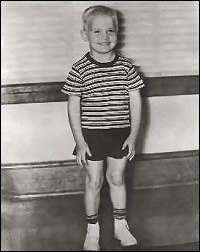 Lee, for some reason, felt guilty. He knew the Yeary’s had made alot of sacrifices for him, and he could have just as easily have grown up in an orphanage if not for them. The Yeary’s were far from rich, and most of the area he grew up in, he later described as completely poverty stricken. Perhaps it was this fact that made him determined to prove his worth to them, in return. His foster brother, five years his senior, was a keen athlete, and it was in this field that Lee decided to “prove” himself. The young Lee, despite his light build, threw himself into one of America’s toughest sport, American Football, with a dedication that made him something of a local idol. at the local high school, and is featured in the Middlesboro Sports Hall of Fame [At the beginning of 2000 Lee helped pay for renovations to the Middlesboro stadium and football field, which was subsequently named after him]. He became a first-line member of the Kentucky All-State High School football team, and his efforts won him a scholarship to University of Indianna.
Lee, for some reason, felt guilty. He knew the Yeary’s had made alot of sacrifices for him, and he could have just as easily have grown up in an orphanage if not for them. The Yeary’s were far from rich, and most of the area he grew up in, he later described as completely poverty stricken. Perhaps it was this fact that made him determined to prove his worth to them, in return. His foster brother, five years his senior, was a keen athlete, and it was in this field that Lee decided to “prove” himself. The young Lee, despite his light build, threw himself into one of America’s toughest sport, American Football, with a dedication that made him something of a local idol. at the local high school, and is featured in the Middlesboro Sports Hall of Fame [At the beginning of 2000 Lee helped pay for renovations to the Middlesboro stadium and football field, which was subsequently named after him]. He became a first-line member of the Kentucky All-State High School football team, and his efforts won him a scholarship to University of Indianna.
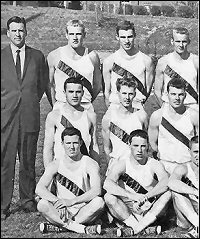 Things were going well, and life was looking rosy for the young sportsman. But during his freshman year Lee sustained a serious back injury. The injury to his lower back was critical, and resulted in him being paralyzed from the waist down for two weeks, and even then he was not assured he would ever walk again and may have to spend the rest of his life in a wheelchair. Lee’s injury was aggravated by the fact that, previously unknown to him or anyone else, he had been suffering from a defect in his spine. The defect resulted in a condition known as spondylolisthesis.
Things were going well, and life was looking rosy for the young sportsman. But during his freshman year Lee sustained a serious back injury. The injury to his lower back was critical, and resulted in him being paralyzed from the waist down for two weeks, and even then he was not assured he would ever walk again and may have to spend the rest of his life in a wheelchair. Lee’s injury was aggravated by the fact that, previously unknown to him or anyone else, he had been suffering from a defect in his spine. The defect resulted in a condition known as spondylolisthesis.
But despite the doctors and experts advice, Lee knew he was going to walk again. He was determined to get out of his hospital bed, and get back to playing football.. Once more, the urge to win, and overcome the odds, spurred him on. To the amazement of everyone, within two weeks he was standing up, and a fortnight after that was able to leave the hospital. “Those two weeks I didn’t think I was going to have a life,” admits Lee. “I was really frightened. You realise how wonderful things really are…how grateful you are for all things. I had to wear a back brace for almost a year”
 It was whilst recovering from his injury that the seventeen year old’s carefree bachelor days came to end, when he met and married Karen Robinson. A year later, in 1962 Lee Majors Jr., was born. Due to the extent of his back injury, Lee was kept from competing in college football for a further two years, and it was only when he transferred to Eastern Kentucky State College, in Richmond, Kentucky that he started playing again, and gained a teaching certificate. Lee attracted the interest of NFL scouts, in his last year at the college and was offered the chance to try out for the St. Louis Cardinals, but his earlier injury, which continued to plague the young Lee Majors over the past couple of years, caused him to turn the offer down after seeking advice from several doctors .It was about this time that a mutual friend introduced Lee to the movie star, Rock Hudson. The two men became firm friends, and from their meeting, Lee’s thoughts turned to acting.
It was whilst recovering from his injury that the seventeen year old’s carefree bachelor days came to end, when he met and married Karen Robinson. A year later, in 1962 Lee Majors Jr., was born. Due to the extent of his back injury, Lee was kept from competing in college football for a further two years, and it was only when he transferred to Eastern Kentucky State College, in Richmond, Kentucky that he started playing again, and gained a teaching certificate. Lee attracted the interest of NFL scouts, in his last year at the college and was offered the chance to try out for the St. Louis Cardinals, but his earlier injury, which continued to plague the young Lee Majors over the past couple of years, caused him to turn the offer down after seeking advice from several doctors .It was about this time that a mutual friend introduced Lee to the movie star, Rock Hudson. The two men became firm friends, and from their meeting, Lee’s thoughts turned to acting.
The Acting Bug
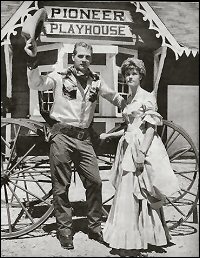 In the Summer of 1962, Lee won a role in a play entitled 7 Husbands, at the Pioneer Playhouse, in Danville, Kentucky, alongside his wife, Kathy. He was interviewed by it’s owner-director, Eben Henson, who thought from the start that “…this man Majors had the right potential. The build, the looks, that go down well on the screen.”. Henson took Lee on at the Playhouse, coached him, and tutored him.
In the Summer of 1962, Lee won a role in a play entitled 7 Husbands, at the Pioneer Playhouse, in Danville, Kentucky, alongside his wife, Kathy. He was interviewed by it’s owner-director, Eben Henson, who thought from the start that “…this man Majors had the right potential. The build, the looks, that go down well on the screen.”. Henson took Lee on at the Playhouse, coached him, and tutored him.
Lee also graduated college in 1962, with a degree in both History and Physical Education, as a well as now being a qualified teacher. Lee college, and football, career behind him, he planned to pursue a career in education combined with coaching. There was something lurking at the back of the newly graduated Lee majors mind. Throughout college he had wanted not to just be a professional football player, but a great one, however his back injury had now put this ambition out of his reach. This was when Lee reconsidered the acting field, rather than the football one. He could still achieve national recognition and world-wide attention through acting, as he had strived for through football. His drive he felt to continually prove himself came to the fore once more, and when friends doubted his chances of making it in Hollywood, Lee replied, “I’m going to make it…I’ve got to!.” He took the decision to move west to California. Quite a move for a small town lad from Kentucky, who had previously never been farther west than Mississippi.
Lee moved to Los Angeles, and became a recreation director for the L.A. Department of Parks and Recreation, in North Hollywood, at a salary of $2.83 and hour, nursing ambitions of a career in acting. The park is located in the San Fernando Valley, and during his free time found himself playing touch football, with other athletically inclined young men, some of whom were actors. Lee chatted with them, listening to their experiences and opinions of their chosen profession. Nothing he heard discouraged him from his ambition to break into acting, in fact, it merely strengthened his resolve to succeed.
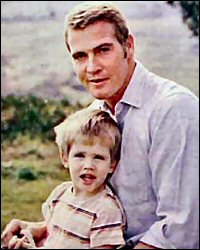 He finally contacted Dick Clayton, for advice on how to break into acting, by boldly turning up at Clayton’s Hollywood’s office, and brazenly talking his way past the agent’s secretary. Clayton took on the “unknown” Majors, much as he had the “unknown” James Dean years earlier, something that was rare in Hollywood, certainly for one the top agents in the business. Clayton became Lee’s advisor and helped him find a drama coach. He also obtained MGM’s permission for Lee to attend the studio drama school – without charge!. Lee enrolled in the MGM drama school, studying under acting teacher, Estelle Harmon.
He finally contacted Dick Clayton, for advice on how to break into acting, by boldly turning up at Clayton’s Hollywood’s office, and brazenly talking his way past the agent’s secretary. Clayton took on the “unknown” Majors, much as he had the “unknown” James Dean years earlier, something that was rare in Hollywood, certainly for one the top agents in the business. Clayton became Lee’s advisor and helped him find a drama coach. He also obtained MGM’s permission for Lee to attend the studio drama school – without charge!. Lee enrolled in the MGM drama school, studying under acting teacher, Estelle Harmon.
1964 turned out to be a year of highs and lows. Lee got his first on-screen role in the Joan Crawford movie Strait-Jacket, credited as Harvey Yearly [he appears, and dies, in the 5 minute pre-credit sequence!], there then followed guest spots on Alfred Hitchcock Presents : “The Monkey’s Paw – A Retelling” and Gunsmoke. Alas, his first marriage also ended this year, and the couple divorced, with Kathy returning to Kentucky with their young son.
Lee's Big Break
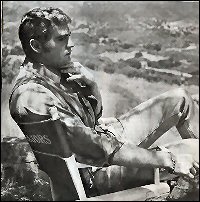 His first big professional role came that same year. After 18 months training with MGM, Clayton told Lee “You’re ready.” and took a rather surprised Lee Majors to his very first interview at CBS Studio Centre, were the producers of a new TV show – The Big Valley – were looking for 3 good-looking male leads. Lee was to audition of the role of Heath Barkley. The competition was intense, with over 400 actors auditioning for the part. Many of them were well-seasoned veterans of TV work, with a long list of credits behind them.
His first big professional role came that same year. After 18 months training with MGM, Clayton told Lee “You’re ready.” and took a rather surprised Lee Majors to his very first interview at CBS Studio Centre, were the producers of a new TV show – The Big Valley – were looking for 3 good-looking male leads. Lee was to audition of the role of Heath Barkley. The competition was intense, with over 400 actors auditioning for the part. Many of them were well-seasoned veterans of TV work, with a long list of credits behind them.
“They asked for my credits,” remembers Lee “and I didn’t have any.” He confesses he was “very scared and nervous” because of the experience of the competition. “I still find it very nerve-wracking. I knew it would be mentally exhausting, though. I was hardly prepared for the physical grind. But it was what I wanted to do.” Lee’s determination and ability won the day, and he was cast on the new show as Heath, Barkley, the illegitimate son of the late Tom Barkley, adopted into the Barkley family in the show’s Pilot episode – in a role which strangely drew on parallels in Lee’s own personal life.
After initially filming the pilot, Lee returned to his job at the park. Even after the series was confirmed as being picked-up by CBS, he kept on working, only handing in his notice two days before regular filming was due to begin. Even then he didn’t quit completely. He asked to remain on the inactive employee list, at the park – “just in case”. He remained on the inactive list for two years, only removing it when he felt secure in his new profession. He needn’t have waited so long….
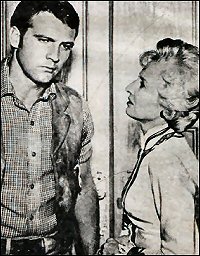 The show was a huge success. The Big Valley put Lee on the first rungs of the ladder to stardom. Barbara Stanwyck lead the cast as the matriarchal head of the Barkley ranch, keeping family and business going after the death of her husband. The cast was complemented by both experience, and youth, with the additions of Richard Long [Jarrod Barkley], Peter Breck [Nick Barkley], and Linda Evans [Audra Barkley] – with whom Lee studied at MGM – to the cast. The family played a major part as pioneers of ranching and empire building, in California’s San Joaquin Valley, circa 1870, and storylines ranged from basic stories of the lives and loves of the Barkley family; to everyday life running a cattle ranch, to various pioneering activities of the era such as the start of the rail-roads and land development; to all-out full-blown cowboys stories of fist-fights and shoot-outs; and even racism; all told through a mix of high drama and soap opera style television. The show aired from 1965-1969, and featured a host of guest stars throughout it’s four-year run.
The show was a huge success. The Big Valley put Lee on the first rungs of the ladder to stardom. Barbara Stanwyck lead the cast as the matriarchal head of the Barkley ranch, keeping family and business going after the death of her husband. The cast was complemented by both experience, and youth, with the additions of Richard Long [Jarrod Barkley], Peter Breck [Nick Barkley], and Linda Evans [Audra Barkley] – with whom Lee studied at MGM – to the cast. The family played a major part as pioneers of ranching and empire building, in California’s San Joaquin Valley, circa 1870, and storylines ranged from basic stories of the lives and loves of the Barkley family; to everyday life running a cattle ranch, to various pioneering activities of the era such as the start of the rail-roads and land development; to all-out full-blown cowboys stories of fist-fights and shoot-outs; and even racism; all told through a mix of high drama and soap opera style television. The show aired from 1965-1969, and featured a host of guest stars throughout it’s four-year run.
Lee worked hard his early days on the show, one of his main doubts early on was the fact that he had never been on a horse before being signed as “Heath”!. He studied his craft and learned his lines with a diligence which was not lost on the rest of the cast. “I’ve learned the basic techniques of acting,” Lee said at the time, “I’ve tried to improve my craft. I’ve watched the directing closely. It’s something important to an actor, especially someone new, to pick up all aspects of the business. I go to dubbing sessions, watch the editors work, even turn up at some of the scoring sessions.”
Whilst working on his first series, Dave Gershenson, Lee’s publicity agent, came across a picture of a young woman who had just come to Hollywood looking for a break in her acting career. That woman was Farrah Fawcett. Gershenson knew his client would like this Texan beauty, and Farrah says “When I first heard from Lee Majors, he was the rudest man I’d ever encountered”. This is probably due to the first time Farrah heard from Lee was when he left a message one her answer machine at the all-girl boarding house Farrah was staying at – “Please tell her that Lee Majors will be by at eight o’clock to pick her up.” “I’m so sorry I left that message,” Lee said. “You know when you work on the set, you can’t always get back to a phone, and I just didn’t want you to make plans.” he told her, almost contritely. Farrah realised that Lee could probably have his pick of any of the girls in Hollywood, at the time, and here he was asking out the new girl in town. It seemed that this handsome actor genuinely wanted to take her out.
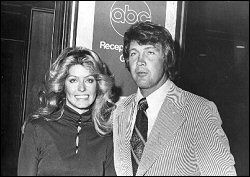 That first night out together was filled with stilted conversation and silences, as the two behaved as if clumsy and ill-at-ease teenagers out on a high school date. Farrah spent part of the evening ill in ladies room – something Lee thought at the time was a hint that she hadn’t wanted to go on the date in the first place. Despite this, Lee was adamant not to let this wonderful girl slip through his fingers, and the next day sent Farrah a gift a bakers dozen – thirteen – of yellow roses [the state flower of Texas]. Farrah was touched by his thoughtfulness, and from then on the couple were inseparable and were soon seen, and photographed, at various Hollywood social events and night spots over the coming months.
That first night out together was filled with stilted conversation and silences, as the two behaved as if clumsy and ill-at-ease teenagers out on a high school date. Farrah spent part of the evening ill in ladies room – something Lee thought at the time was a hint that she hadn’t wanted to go on the date in the first place. Despite this, Lee was adamant not to let this wonderful girl slip through his fingers, and the next day sent Farrah a gift a bakers dozen – thirteen – of yellow roses [the state flower of Texas]. Farrah was touched by his thoughtfulness, and from then on the couple were inseparable and were soon seen, and photographed, at various Hollywood social events and night spots over the coming months.
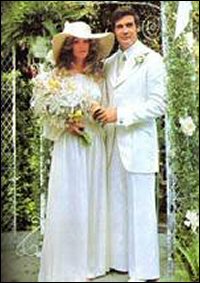 Lee and Farrah eventually married, on the fifth anniversary of their first date: July 28th 1973, in a garden ceremony in the Bel-Air Hotel. The best man was Harvey Yeary, Lee’s father, and matron of honor was Diane Walls, Farrah’s sister. Also present amongst the one-hundred and fifty-plus guests was 11 year-old Lee Jr., to see his father take his new bride. Theodore Van Runkle, the famed costume designer, created original outfits for the entire bridal party. You only need to look at any photographs from the wedding, to see what a special day it was for Lee and the new Mrs. Majors.
Lee and Farrah eventually married, on the fifth anniversary of their first date: July 28th 1973, in a garden ceremony in the Bel-Air Hotel. The best man was Harvey Yeary, Lee’s father, and matron of honor was Diane Walls, Farrah’s sister. Also present amongst the one-hundred and fifty-plus guests was 11 year-old Lee Jr., to see his father take his new bride. Theodore Van Runkle, the famed costume designer, created original outfits for the entire bridal party. You only need to look at any photographs from the wedding, to see what a special day it was for Lee and the new Mrs. Majors.
Back to Lee’s career…1968 saw Lee his first big movie break alongside Charlton Heston in Will Penny, a western which is credited as portraying a “realistic” view of a cowboy’s life in the old west, unlike the usual Hollywood version. Lee had to turn down a role in a John Schlesinger movie, because of a fourteen-week shooting schedule in New York, the movie being Midnight Cowboy. Lee would have played the part which shot another young actor to stardom, the “newcomer” Jon Voight. The end of the Sixties, saw the cancellation of The Big Valley. but Lee was anything but idle. A second movie, The Liberation of L.B. Jones, co-starring with Lee J. Cobb and Roscoe Lee Browne, was followed by another TV series The Men From Shiloh, a revamped The Virginian for it’s final year. Lee portrayed Roy Tate, a mysterious ranch hand with a dark past, in another Western series, on the Shiloh Ranch, situated near Medicine Bow, Wyoming, in the 1890’s. Two ABC movies resulted in critical acclaim for Lee’s acting: Weekend of Terror and The Ballard of Andy Crocker.

Biography
Read about Lee's childhood an, his high school years and how he got into acting.
Filmography
A comprehensive look at the films and TV roles that lee has been in throughout his career.
Lee & Farrah Fawcett
Lee and Farrah, THE Golden Couple of the 1970's how they met and what went wrong.
Lee & Faith
Lee wed Faith in 2002 - learn more about the lady that turned Lee's life around.